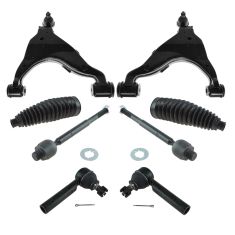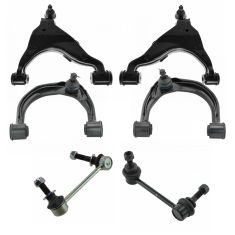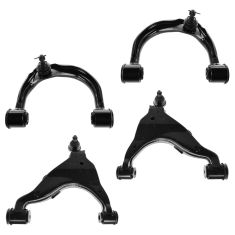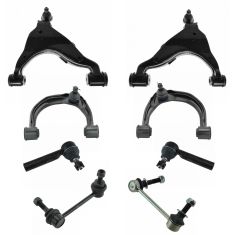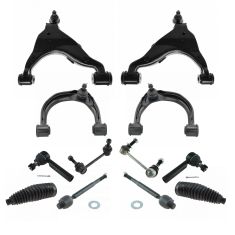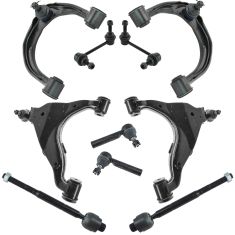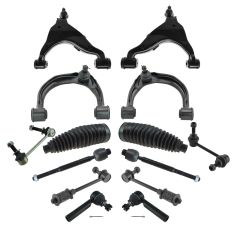1ASFK01969-Toyota Lexus Front Driver & Passenger Side Lower 2 Piece Control Arm with Ball Joint Set TRQ PSA62475
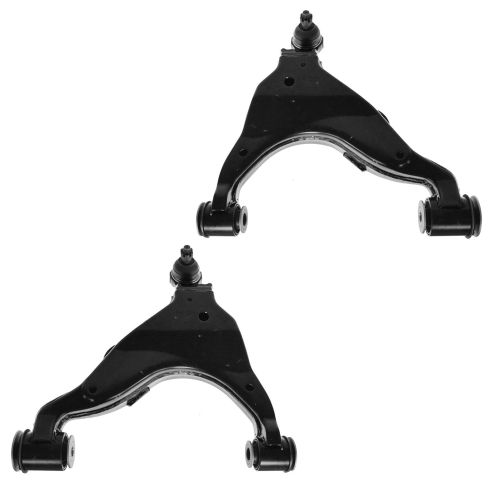
Replaces
2008 Lexus GX470 without Adaptive Suspension Front Driver & Passenger Side Lower 2 Piece Control Arm with Ball Joint Set TRQ PSA62475

You may also like
Product Reviews
Loading reviews
4.82/ 5.0
44
44 reviews
Great product
March 16, 2017
Great pricing and very fast delivery would use them again and have told several friends about their site as well. Can't see any difference from the parts I got and the OEM ones on my truck.
04 4runner
February 2, 2018
Nice fit and finish on these and a great deal for the price longevity remains to be seen, overall very happy
Seem ok!
May 12, 2018
These look just like Toyota OEM, time will tell how they hold up. Only gave 4 stars because the box they were shipped in was pretty crappy. It was completely destroyed by the time it got to my front door and there was basically no protection in the inside but with that said nothing seemed to be damaged. Great price though
Upper and lower control arms with ball joints
March 18, 2019
Lower ball joints at driver side needed replacement... Because of the reasonable parts price with 1A... I decided to replace the four front control arms with bushings and ball joints... The parts were a perfect fit.
lower control arm; 04 Toyota 4Runner 4x4
June 26, 2019
it did the trick.. cant complain.. a good replacement part. Good for daily driving and light off road (fire roads). Dont expect to go rock crawling with these. Its an OEM replacement lower control arm.
Fit just fine
September 14, 2019
Price was good shipping was good and fit was good. Highly suggest getting the Moog greasable bolts that go in the bushings on the frame. Grease the heck out of those and install those with these new arms and you'll be good to go. The only reason for the four star rating is because 1A Auto put me on their emailing list that I didn't ask for and they keep asking me to write reviews. I just want to buy a product get it shipped and be done. Otherwise no issues.
Great product!
November 13, 2019
Thanks 1a! Parts fit my fj cruiser perfectly! Super fast shipping too!
Lower control arm
March 12, 2020
Overall it looks to be of good quality and fitment was good. Reasonably priced also.
06 4Runner LCA
April 6, 2020
Arms sipped quick, came in great shape, and bolted up just fine. Would buy again!
Worked good
April 18, 2020
Well pleased,good quality, worked good
Great product
June 30, 2020
Matches factory control arms on my 2007 4Runner. Fit well. Do not replace the alignment cam bolts with centric brand. They all stripped out immediately. Spc bolts worked very well for me afterwards which I picked up at autozone.
1A Auto is always my 1st choice!
October 20, 2020
1A Auto is my go to for guaranteed fit, low cost parts. Each purchase reinforces my expectations for professional assistance and great customer service.
My recent purchase of the Toyota Front Lower 2 Piece Control Arm with Ball Joint Set was no different. Knowing Im getting the best possible parts for my 2006 4Runner gives me peace of mind. My Toyota dealership does all my installation work, and theyve never had any concerns regarding fit or quality of the product. In fact, they keep asking me to sell it back to them because they and 1A Auto keep it in such great shape.
In addition to the online service, 1A Auto also provides easy to understand installation videos for almost everything they sell. And if you need to ask for advice before or after your purchase, the staff answering the phones are especially knowledgeable and friendly. And then theres the 1A Auto blog. Another great resource.
And lastly, though Id gladly pay shipping, 1A Auto provides fast and free shipping. What a great
Perfect Fit
October 25, 2020
Great OEM replacement with a new ball joint already installed! No grease fittings, but the quality is good and n exact fit. If you are looking to freshen up your ride and want to achieve a solid alignment, i do recommend these!
GB Midwest rust belt
It fits
November 23, 2020
They fit on my 2008, but these are actually the 2010-2014 model because they have the wider lower strut seat. 1A doesn't list lower control arms for 10-14 models but these are them.
Great product, Great price
January 25, 2021
I recently purchased these to replace my worn out factory units as recommended by a friend. Ive had them on about a month now and they feel fantastic, look to be great quality visibly and the ball joint feels nice and solid. Would use again but probably wont have to ???? Will definitely be purchasing parts for other vehicles through 1A
Great OEM replacement
July 6, 2021
Great quality and with the help of the installation video, it was an easy DIY driveway project.
August 19, 2021
Received as described and on time
Good replacement
September 3, 2021
Good and fit well steered a little bit light than original
October 14, 2021
Easy to install and really good quality
Get both sides done at one time and have peace of mine that your front end will be fine!
April 4, 2022
Great products got the front end smooth no rattles and easy install! For what the bushings cost and the ball joints this is a more sensible approach . If you had it apart had a way to put the bushings in along with the ball joints it would take more time ! Buying the whole a arm and both of them just is peace of mind ! I will take my old ones and put the new ball joints in them, buy better than the stock bushings . Then rebuild them in my spare time! Ive lifted mine up were i need to change the angle of my bottom ball joint so I will have that done as well !
May 14, 2022
Perfect fit...
May 18, 2022
Came quickly and fit perfectly for my 05 4th gen 4Runner
Good product
May 27, 2022
Cool stuff!!
May 28, 2022
perfect fit and it is even lighter heavier than my OEM lcas.
Lower control arm install.
June 25, 2022
The part are great. Fit for and function of the original part.
But I had to cut the cam bolts out due to rust on the old part.
July 27, 2022
perfect fit, appreciate that the price included the bushings.
Can't tell a difference from the originals
August 24, 2022
Very similar to OEM. Followed some 4runner forum recommendations to purchase these control arms from 1A as replacement. Overall seem good so far.
December 13, 2022
The parts are great. I just wish your video would have showed the removal of both cam bolts. It should have been a red flag for me when the video skipped ahead and you were putting new bolts in. It would have saved me a lot of time if I knew I should have a new bolt kit on hand because I was going to have to destroy the old bolt/sleeve. Normally your videos are better but I got it done still. Thank you.
They do the job, so far!
January 30, 2023
They fit great, so far they work and haven't had any issues. 2005 Toyota 4runner Limited V8 on 35s. Not a pavement princess.
January 30, 2023
No issues going in. Everything lined up on 2006 Toyota 4runner SR5
'07 4runner Ltd
[{"url": "https://wac.edgecastcdn.net/001A39/prod/media/pNISJll75W64CYGsite/6a3638a1a4d862ac5b9bd63f262c63ac_1675427596870_0.jpeg", "caption": "Fit perfectly on my '07 4runner Limited."}]
February 3, 2023
These were great and the installation was easy. Fit just like the factory set.
LCA
[{"url": "https://wac.edgecastcdn.net/001A39/prod/media/pNISJll75W64CYGsite/024f114fabc808d298280850b2b8ec2b_1689577264014_0.jpeg", "caption": "2003 4Runner with new 3\" lift"}]
July 17, 2023
Fit right. Look clean. Riding smooth and quiet. ????
Great for now
August 16, 2023
Look to be good quality arms but not able to tell the longevity of the bushings or ball joint. At this price point and with how simple the replacement is, you could do this job 3 or 4 times over before breaking even with a new OEM set.
Biggest complication will be your old arm bushings seizing in place so prepare with a STEEL DEMON CARBIDE (trust me) sawzall blade. You'll have to order new alignment cam bolts after that and also remember to anti-seize them (not the threads!) before placing back in.
Good value
August 24, 2023
Good value for the price even though they do not feel exactly same as OEM. However, it is just $200 a pair instead of $800 for oem.
Great solution to aging OEM
September 21, 2023
I bought these to be installed when I was lifting my GX470. The originals had 155k miles on them and I could hear random noises from up front. The difference is night and day, my 15 year old Lexus feels tight and solid, handling is dramatically improved. If you have old ball joints, save the effort and go with new arms that have fresh bushings and ball joints. Would buy again.
Direct Fit
October 21, 2023
Bolted right up to our 2005 4Runner Limited V8. Ride is improved.
Quality LCA for FJ Cruiser
November 20, 2023
Great price. Exact match for the 2008 FJ Cruiser. Well built.
December 26, 2023
The reason I bought these control arms over others was the replacement video starring the guy with the beard. After original control arm was removed, he side by side compared the new with the old. This is what I needed to see. The product was of high quality and looked identical. As usual. I appreciate your videos. Thanks!
Best place for parts
January 2, 2024
Best place for the price and deliver on time
Great parts and service
January 24, 2024
The Control arms we received were very professional; the bushing looked good.
And the parts arrived on time.
The box 'did have some damage but it didn't harm the parts.
Would have liked a cotter pin for the castle nut.
2005 Toyota 4Runner V8
July 5, 2024
2005 4Runner V8 SR5.
Perfect and are holding up great 3 years later.
Great product!
July 12, 2024
My car is smooth running. Ty!!!
It's the same as the OEM.
[{"url": "https://wac.edgecastcdn.net/001A39/prod/media/pNISJll75W64CYGsite/e8315c130c612250346b6e2c75a83e14_1728238943268_0.jpeg", "caption": "Everything broke and bent but those parts lasted."}]
October 6, 2024
Is was a great product until a lady ran the red light. ++++ to the product
Smooth as Butter
[{"url": "https://wac.edgecastcdn.net/001A39/prod/media/pNISJll75W64CYGsite/a399f0b3d4162fd856c6e76aa07b3bd7_1731374405945_0.jpeg", "caption": "Fits like a glove! 04 4Runner."}]
November 11, 2024
Phenomenal! Fits and rides super smooth! 04 4Runner
Customer Q&A
My GX 470 has the height adjusting feature will these fit My GX470?
June 1, 2018
10
They will if your control arms are the same part number.
June 1, 2018
Bret W
Who makes this arms? Whats the brand?
March 27, 2019
10
1A Auto's house brand parts are manufactured by various aftermarket companies specifically for us and built to your vehicle's exact OEM specifications.
March 27, 2019
Emma F
This this come with driver and passenger lower control arm? And how long will this last me?
April 8, 2019
10
Yes it does. And so far 2 years strong in a lifted vehicle.
April 8, 2019
Patrick C
10
This will come with both the driver and passenger side and it should last you for the lifetime of your vehicle.
April 8, 2019
Emma F
10
Yes I bought the same thing and it came with everything and fit perfect and had no issues at the alignment shop. I have had mine for 2 years so far but my passenger balljoint is worn and needs replaced. Drivers side is good so far though. Hope this helps
April 8, 2019
Randy V
What is the brand name of these control arms?
August 1, 2019
10
1A Autos house brand parts are manufactured by various aftermarket companies specifically for us and built to your vehicles exact OEM specifications. Please let us know if you have any other questions.
August 1, 2019
Emma F
10
These control arms are from our 1A Auto in-house brand. We have all of our parts manufactured to exact OE specifications, so they will fit and function just like the original parts that came on your vehicle. These will also be covered by a limited lifetime warranty, so if for some reason they fail under intended use, we will send a replacement part at no extra charge. Please contact us if you have any further questions.
August 1, 2019
A C
Are the bushings rubber like Toyota OEM LCAs?
April 6, 2022
10
Yes.
April 6, 2022
B I
10
Yes bushings look very similar to OEM. I have about 10k hard miles so far on these since I installed and they still look like new.
April 6, 2022
T I
10
Yes, they are. Rubber inside a steel shell with steel sleeve molded in center for through bolt.
April 6, 2022
Ron R
will these work on a 2010 fj crusier?
September 2, 2022
10
Currently, we do not carry this part for your vehicle. We're always updating our inventory so please check back soon!
September 2, 2022
Emma F
Will this fit on 3 inch litfted 4runner?
October 7, 2022
10
I installed these when I did my 2.5 inch lift and had no issues. They work fine and was able to align correctly.
October 7, 2022
Ryan M
10
Yes it will fit great. I have had them on my 2003 Toyota 4Runner With a 3 inch lift for about 40,000 miles. So far so good! I Off Road regularly and Im not gentle with the vehicle. They have held up great! Also much more reasonably priced than any of the competitors
October 7, 2022
J R
10
Yes. I have a 3" lift and run these. No issues with them.
October 7, 2022
John S
10
Our control arms are designed to be direct replacements for the original factory parts. Installing our parts on a modified vehicle will void the warranty.
October 7, 2022
Kelly S
How does the strut fit into the mounting position. Too wide or perfect fit?
January 19, 2023
10
Perfect fit. Have had these on for a year or so and working great.
January 19, 2023
Christopher A
10
These are made to OE spec, so the struts will fit like they did on the originals. We do have installation instructions available for this part. Here's a link for that: https://www.youtube.com/watch?v=phALDrgx1bs
January 20, 2023
T I
10
They fit great!
January 30, 2023
Ruben I
10
My Billsien 5100s fit perfectly. I had the old lowers installed first and added these after the lift was in.
February 3, 2023
David S
Do ball joints need greasing? Or are a metal on polymer joint?
January 30, 2023
10
I don't remember 100% but I am pretty sure I did grease them myself before installation.
January 30, 2023
Ruben I
10
Our steering and suspension components are pre-greased and sealed for long life and do not require the extra maintenance typically required by greaseable versions.
January 31, 2023
T I
Does this come with all the hardware and new bolts and pins?
April 10, 2024
10
It doesn't.
April 10, 2024
Jacob L
10
New hardware is not included with this item. You may be able to reuse your original hardware if it is in good condition.
April 10, 2024
Emma F
Lexus is a registered trademark of Toyota Motor Corporation. 1A Auto is not affiliated with or sponsored by Lexus or Toyota Motor Corporation.
See all trademarks.











